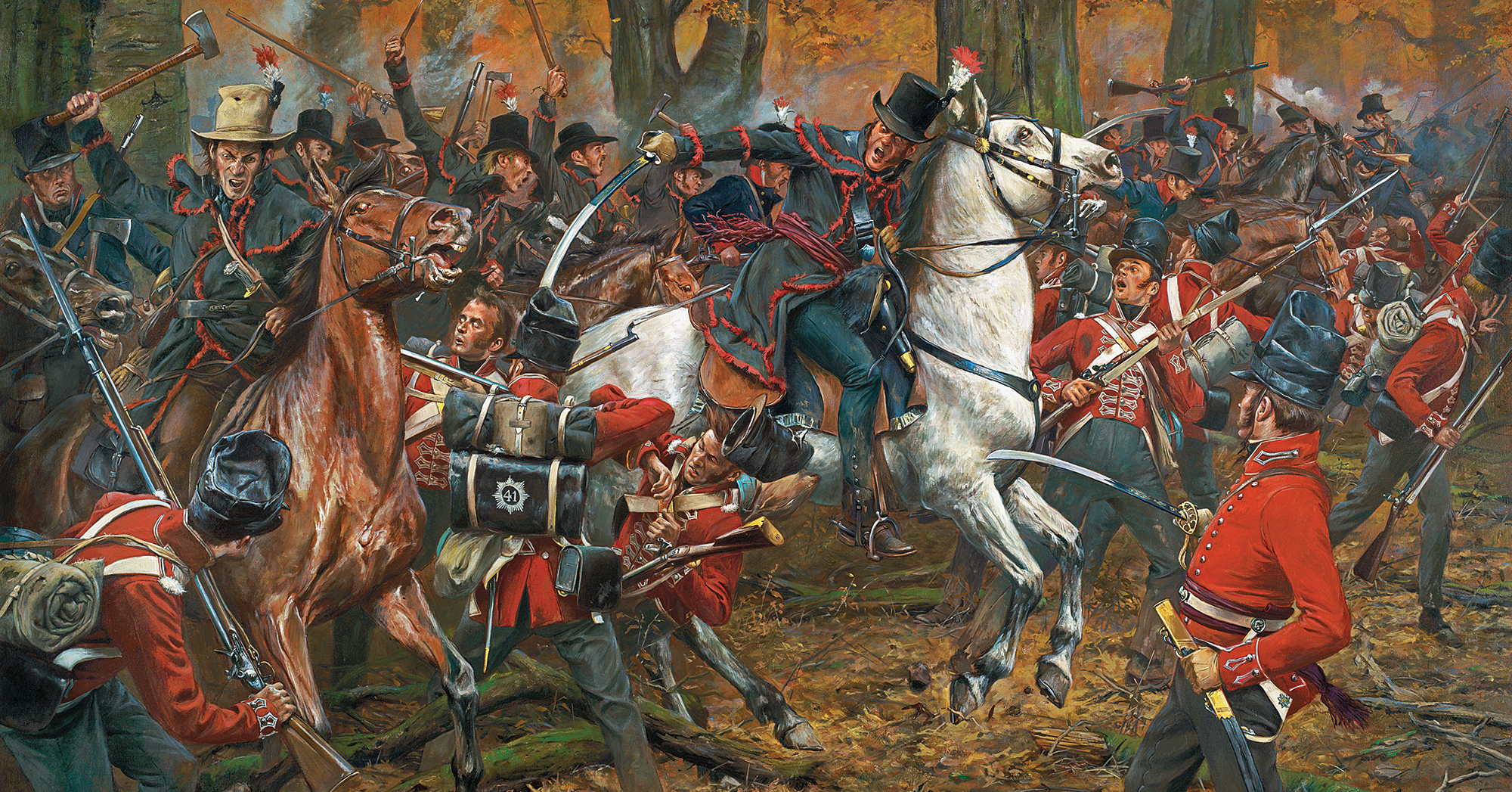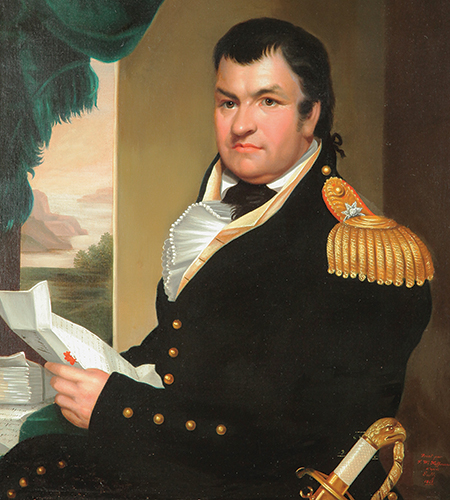
In late October 1814, deep into the War of 1812, a flying column of American horsemen riding east under a full moon reached the Thames River near Moraviantown, a settlement of Christianized Delaware Indians who had retreated to Upper Canada in the wake of the American Revolution. Led by Brig. Gen. Duncan McArthur, the riders had left Fort Detroit eight days earlier bound for the British army base at Burlington Heights, on the western tip of Lake Ontario.
The mission of the American incursion was twofold. First, McArthur intended to destroy mills, bridges, livestock and foodstuffs across western Upper Canada (present-day southeastern Ontario), thus rendering the region incapable of supporting British troops. Second, he hoped to isolate the Niagara Peninsula, between Lakes Ontario and Erie, and force the British to abandon Upper Canada west of York (present-day Toronto). In his 1816 history of the war Robert B. McAfee, an American veteran of the campaigns in Upper Canada, described what became known as “McArthur’s Raid” as “an expedition which was not surpassed during the war in boldness of its design and the address with which it was conducted.”
McArthur was the perfect candidate to lead a band of horsemen some 200 miles into the British rear. Tougher than shoe leather, born poor and raised on the Pennsylvania frontier with no formal education, he became one of the earliest American trailblazers to Kentucky. He later helped survey Ohio’s first capital, Chillicothe, at the confluence of the Scioto River and Paint Creek, and was ultimately elected that state’s 11th governor. Along the way he accumulated vast tracts of land. But the uncompromising influence of the then-savage Kentucky backwoods never left him. McArthur exemplified a popular expression of the era, later attributed to David Crockett, that Kentuckians were “half horse, half alligator, tipped off with the snapping turtle.” While not a Kentuckian by birth, he was by temperament and action.
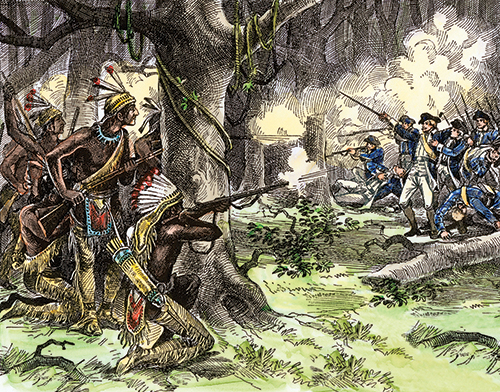
McArthur (his father spelled it MacArthur) was born in 1772 in Dutchess County, on the Albany River 80 miles north of New York City. The eldest of seven siblings, he lost his mother when still very young. In 1780 his father moved the family to western Pennsylvania, the frontier of the nascent United States. By the time Duncan was 12 he was hiring out to neighboring farms as a laborer—once he’d helped harvest his father’s crops. Soon thereafter he began working as a mule skinner with the packtrains beginning to cross the Appalachians. Remarkably, he somehow managed to learn to read and write, a comparatively rare skill on the frontier. At age 18 he joined the Pennsylvania militia and participated in brevet Brig. Gen. Josiah Harmar’s disastrous 1790 campaign against British-allied American Indians in what is now the Midwest. Young McArthur also participated in an unsuccessful follow-up campaign in 1792.
A hard officer who did not hesitate to burn Indian villages, McArthur was undaunted by wilderness and seemingly immune to his own pain and that of others
In the spring of 1793 surveyor Nathaniel Massie hired McArthur as a rodman on his Northwest Territory expedition to map the Scioto River valley from its juncture with the Ohio River north to Paint Creek and beyond. Massie took to the young man, encouraged him to study rudimentary mathematics and continued to employ him as an assistant. At the time it was customary for a surveyors to be paid all or part of their fee in kind as a percentage of the land surveyed. Further, while performing the contracted survey, they would keep an eye out for any land to which they could lay claim. According to an 1838 biography by John McDonald—McArthur’s biographer, brother-in-law and former quartermaster—“McArthur made tomahawk improvements [i.e., informal claims] in many of the finest bottoms on the east side of the Scioto River.”
Historian Andrew R.L. Cayton argues that as land speculation and settlement “was by design a highly individualistic, competitive business…men simply took as much land as they could obtain warrants to cover.” McDonald was blunt regarding his brother-in-law’s ambition. “Although he has been successful in his land speculations,” he wrote of McArthur, “his conduct in this line of business is not worthy of imitation, but rather reprehensible, and has created him more vexation and enemies than all the other acts of his life.” That ruthlessness carried over into his military career. A hard officer who did not hesitate to burn Indian villages, McArthur was undaunted by wilderness and seemingly immune to his own pain and that of others.
In 1798 McArthur was appointed a militia captain in the Northwest Territory. In 1806, three years after Ohio was admitted into the union, he was elected colonel of the 1st Regiment, 2nd Brigade, 2nd Division of the state militia. Two years later he was promoted to major general and given command of the division. He proved as much of a comer in politics. In 1804 McArthur was elected to the Ohio House of Representatives. A year later he was elected to the Ohio Senate, and in 1809 he became speaker of the Senate.
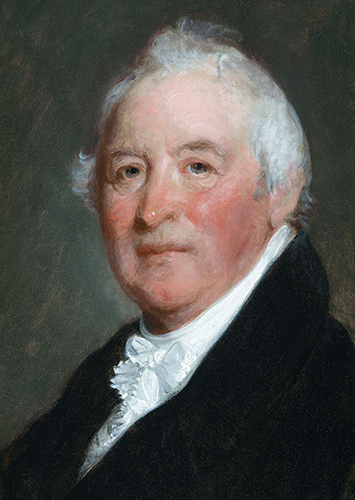
In May 1812, with war looming, McArthur rallied the militia and was commissioned colonel of the newly formed 1st Regiment of Ohio volunteers. He led the regiment north to Detroit, arriving on July 5. By then Congress had declared war against Britain. A month later, as British Maj. Gen. Isaac Brock prepared to assault Detroit, Brig. Gen. William Hull, the governor of Michigan Territory, detached troops to meet a vital supply column. On August 14, with 500 men between them, Cols. McArthur and Lewis Cass were sent to escort the 150-man column north through the Great Black Swamp. After a day’s march they were summoned back to Detroit with all haste. They arrived on August 16 to the shocking news Hull had surrendered the garrison after only a perfunctory British bombardment and had included their respective regiments in the terms of capitulation. Though technically a prisoner of war, McArthur was free to return home on a promise not to resume arms. Having literally and figuratively fought for everything he had in life, the situation must have rankled. He’d been defeated by proxy.
In April 1813 McArthur was included on paper in a parolee exchange, freeing him for service, and he immediately enlisted in the U.S. Army with the rank of brigadier general of volunteers. While that summer proved relatively uneventful, fall brought welcome action. On September 10 Master Commandant Oliver Hazard Perry’s Lake Erie squadron of nine ships soundly defeated their British opposites, claiming all six enemy vessels as prizes. With command of the lake lost, British Maj. Gen. Henry Procter abandoned and burned Fort Malden, at the mouth of the Detroit River, and fled east. Brig. Gen. William Henry Harrison set off in pursuit of the retreating Redcoats, bringing them to battle on October 5 along the Thames just shy of Moraviantown. Retreating in disorder, the British fled farther east.
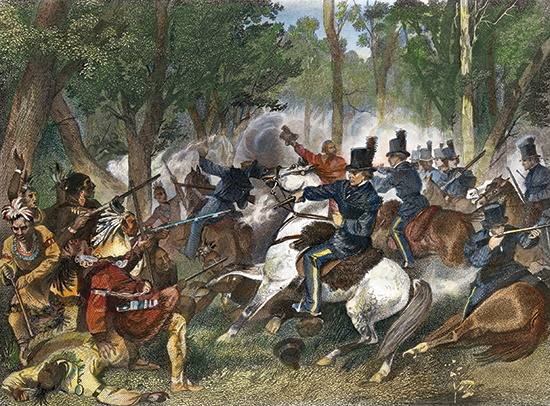
McArthur, though second-in-command of the Army of the Northwest, was not present at the Battle of the Thames. Harrison had ordered him to remain at Detroit in command of the garrison. Thus tasked with literally “holding the fort” three days’ march west of the action, he was deprived of an opportunity to get in on the victory. After two campaigning seasons McArthur remained unbloodied and frustrated.
He returned to Chillicothe for the winter. But the next spring personal hardship only added to his frustrations. McArthur resided in Fruit Hill, an elegant stone mansion overlooking town and the Scioto River valley. On the morning of April 15, 1814, a massive conflagration razed the house.
Over the following months of relative inactivity McArthur smoldered. The hand of fate had frustrated him through three campaign seasons, leaving him on the fringes of battle. As the leaves turned color, he grew hellbent on finally making his mark in a war that had thus far sidelined him. “The summer of 1814 was passing away on the northwestern frontier without affording his enterprising genius an opportunity of striking a blow at the enemy,” McDonald wrote. “He began to think of making an excursion through Upper Canada, to pass through the enemy’s country till he should join the army of Gen. [Jacob] Brown near the falls of Niagara.”
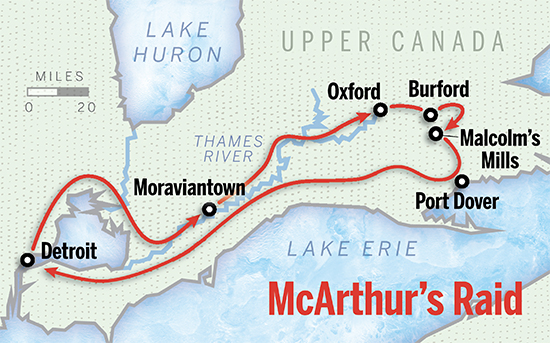
According to McArthur’s after-action report, the force he assembled for his foray behind enemy lines comprised “mounted troops, consisting of 600 volunteers, 50 United States rangers and 70 Indians.” Each rider carried 12 days of rations. Most of the volunteers were Kentuckians under the field command of Maj. Peter Dudley, the remainder McArthur’s fellow Ohioans. No artillery, no baggage and no wagons would slow them down.
As McArthur proposed to spend weeks marauding through Upper Canada, secrecy and dissimulation were essential. Even the men assigned to the raid were kept largely in the dark. McArthur’s general orders enjoined his troops “to prepare for a short, rapid and, it is believed, a brilliant expedition—one which may be attended with some danger and may require all their fortitude to produce a successful issue.” The general encouraged an erroneous rumor the operation was headed north to a restive Indian village at the mouth of the Saginaw River on the western shore of Lake Huron. To reinforce that impression, he had the column initially march north along the western shore of Lake St. Clair before crossing east into Upper Canada north of the lake on October 25. Advancing rapidly up the Thames Valley, McArthur took precautions to ensure no word of his progress preceded him. As the column approached Moraviantown, he had his rangers surreptitiously flank the hamlet and establish roadblocks to prevent escapees from spreading word east of the American incursion.
In his report McArthur boasted that his precautions bore fruit. “We were very fortunate at this place [Moraviantown] in taking a sergeant in the British service who was proceeding to Burlington with the information that the detachment had passed into the enemy’s territory.” The Americans were able to maintain that surprise—or so it seemed. “We were thus enabled to arrive at the town of Oxford, 150 miles distant from Detroit, before the inhabitants knew that a force was approaching,” McArthur wrote. On his arrival in each successive settlement the general announced his troops would respect private property provided residents remained peaceably within their homes. Mills, bridges and public buildings would be destroyed.
His strategy relied on speed and surprise, and he had no intention of being drawn into a set-piece battle against British regulars established on the opposite bank of a swollen river
Unknown to McArthur, however, the enemy had already been alerted to his presence. On October 26 British Lt. Col. William Smelt of the 103rd Regiment of Foot sent a dispatch from his position at Burlington Heights to the commanding officer at York, noting, “There is a report of another party coming down from Detroit.” On November 3 Oxford residents George Nichol and Jacob Wood, having gotten wind of the Americans’ imminent arrival, dashed east some 16 miles to Burford, alerting Lt. Col. Henry Bostwick and his 1st Regiment of Oxford militia to the incursion. Bostwick duly reported to the commanding officer at Port Dover, on the north shore of Lake Erie, that a force of “undisciplined” Kentuckians was rampaging through intent on “ravaging this district.” On arriving in Oxford the next day and learning of Nichol and Wood’s intelligence mission, McArthur, true to his word, burned their houses and outbuildings, Wood’s joiner’s shop and Nichol’s mill.
The next morning McArthur advanced to Burford, 9 miles west of Brant’s Ford on the Grand River (opposite present-day Brantford). He found the village undefended. Bostwick, realizing he was outnumbered, had moved his militia southeast 7 miles to Malcolm’s Mills (present-day Oakland). There the British colonel laid plans to link up with other militia units and assemble a force capable of engaging McArthur. Meanwhile, after plundering for provisions and torching the schoolhouse, the Americans marched west to the ford.
There for the first time they encountered significant resistance. Captain Adam Muir and 50 British regulars of the 41st Regiment of Foot had raced to the ford from Culver’s Inn, south of Simcoe, arriving late the previous afternoon. Soon joining them were elements of the 19th Light Dragoons under Capt. Peter Chambers and Mohawk warriors of the Six Nations under Capt. John Norton. Deploying on the east bank of the Grand, they intended to contest any crossing and were expecting further reinforcements and cannons from Burlington Heights.
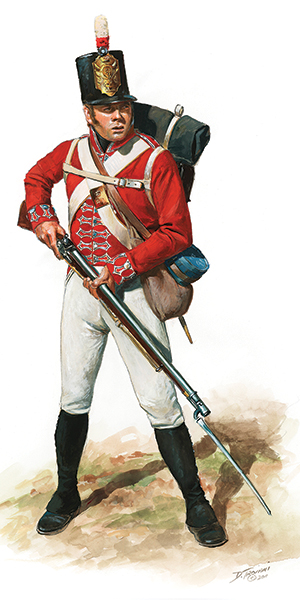
Declining combat, McArthur left a small rearguard at the ford and wheeled south. His strategy relied on speed and surprise, and he had no intention of being drawn into a set-piece battle against British regulars established on the opposite bank of a swollen river. On reaching a safe distance from the ford, McArthur’s troops bivouacked for the night. The next morning they resumed riding south. As the raiders passed through Mohawk (present-day Mount Pleasant), they burned homes in the hamlet and Thomas Perrin’s gristmill on Mount Pleasant Creek. Around noon on November 6 McArthur’s vanguard arrived at Maple Grove, two miles north of Malcolm’s Mills.
South of Maple Grove the terrain rises gradually to a low ridge just north of Malcolm’s Mills. From atop the ridge the ground drops to a 200-yard-wide plain bisected by Malcolm’s Creek before rising sharply again on the south side. To the right of the plain, beside a millpond some 220 yards west of a central bridge over the creek, stood brothers John and Finlay Malcolm’s gristmill and sawmill.
Having had days to prepare, the local militia had removed the planks from the bridge, prepared defensive positions atop the ridge south of the creek and constructed a roadblock of brush and logs between the creek and the heights. Bostwick believed the millpond and adjacent marshy ground were sufficient to secure his left flank, while the swift, deep creek itself would thwart any attempt to cross. Richard Shaver, the retired director of the Canadian Military Heritage Museum in Brantford, describes the colonel’s selection of a battlefield and defensive preparations as “absolutely excellent.” Bostwick’s force comprised some 550 militiamen and one British regular, Sgt. Charles Collins, detached from the 41st Regiment. Though the colonel had chosen the battlefield wisely, he was no match for a determined McArthur.
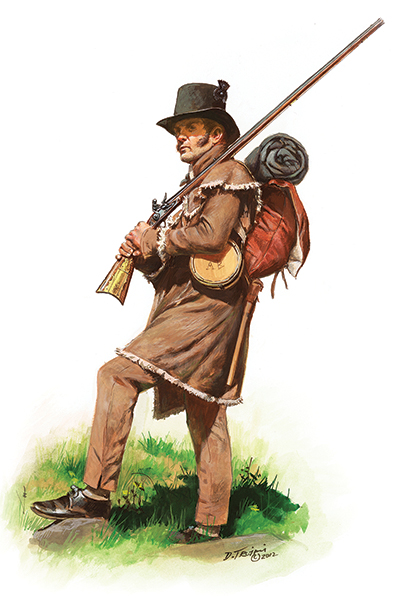
To give the false impression of a direct assault, the American commander had his Kentucky militiamen keep up a steady fire on Bostwick’s front. He then personally led the Ohio militia through the woods on a sweeping probe downstream, where they had the good fortune to find a raft of driftwood spanning the creek. Once across, his men attacked the militia from the rear, signaling the Kentuckians to pour across the frame of the bridge. Alerted to the pincer attack by whoops from McArthur’s excited Indians, the Canadians were able to flee from their strong defensive position before the raiders could bag the entire party.
“One captain and 17 privates killed, nine privates wounded, and three captains, five subalterns and 103 privates made prisoners,” McArthur reported of Canadian losses. His own casualties numbered one killed and six wounded. The figures conflict with Canadian reports of only two fatalities—namely Sgt. Collins and Pvt. Edwin Barton of the 1st Regiment of Norfolk militia. Regardless, the militia broke and ran, leaving the Americans free to proceed unmolested.
McArthur did not pursue the fleeing militia, but he did burn the Malcolm brothers’ mills. Riding south, the raiders skirmished with the British and destroyed two other mills before reaching Port Dover and also disabling its mills. On November 8 they withdrew west along the north shore of Lake Erie, arriving in Detroit on the 17th, their mission accomplished. “The resources of the enemy have been essentially impaired,” McArthur crowed in his report, “and the destruction of the valuable mills in the vicinity of the Grand River, employed in the support of the army in the [Niagara] peninsula, together with the consumption of forage and provisions necessary for the troops has added to the barrier…against any attempts which may be made this winter in the direction of Detroit.” The raiders had struck a significant blow against the British and secured the approaches to the vital American garrison, all at very little cost in terms of resources and casualties. McArthur’s Raid had been a stunning success.
The raid reveals a great deal about both McArthur’s concept of warfare and his character. His objective had been economic—to render western Upper Canada incapable of provisioning British troops—and he had no qualms about destroying public and private property if it harmed the enemy. He had been equally determined to avoid a pitched battle with British regulars and suffer casualties he could ill afford. A consummate strategist, McArthur understood he could not allow combat to distract from the mission objective.
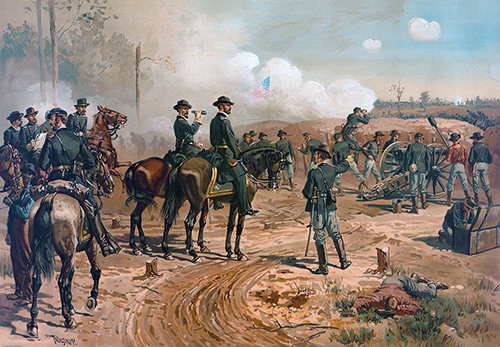
McArthur’s Raid also provides a textbook example of asymmetric warfare. Living off the land, relying on speed and avoiding combat, his small, mobile force had wreaked havoc in the enemy’s vulnerable rear areas. American irregular forces had won a lightning guerrilla campaign against an established, hegemonic British empire. At some level the raid presaged Maj. Gen. William Tecumseh Sherman’s March to the Sea precisely 50 years later. Whereas McArthur focused on destroying mills, making it impossible for the enemy to render grain into flour and timber into lumber, Sherman targeted railroads, breaking the enemy supply line. A half century almost to the day before Sherman’s army set off for Savannah, leaving behind a smoldering Atlanta, McArthur rode triumphantly into Detroit. If Sherman’s March to the Sea represented the dawn of total war, McArthur’s Raid at very least presaged, and perhaps informed, that apocalyptic rampage. MH
Ontario-based historian Bob Gordon specializes in Canadian military and social history. His most recent book is The Bad Detective: The True Story of a Victorian Sleuth. For further reading he recommends History of the Late War in the Western Country, by Robert B. McAfee; Biographical Sketches of Gen. Nathaniel Massie, Gen. Duncan McArthur, Capt. William Wells and Gen. Simon Kenton, by John McDonald; and Malcolm’s Mills: The Last Canadian Battle of the War of 1812, by Andrea Westfall. This article was published in the January 2022 issue of Military History.

